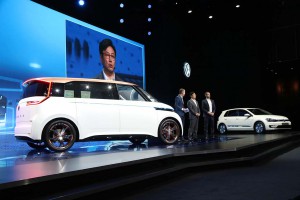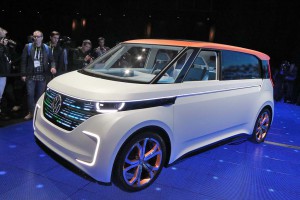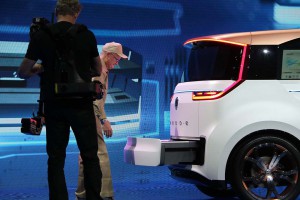
Volkswagen officials show off the maker's new battery electric minivan concept, BUDD-e, at the Consumer Electronics Show 2016.
We all can use a friend, sometimes more than others. And so, during the current diesel emissions crisis, it’s perhaps all the more significant that Volkswagen has come up with a new BUDD-e.
That’s the name of a connected, battery-powered minivan, one of two high-tech concept vehicles that the German automaker unveiled during a long and splashy news conference at the 2016 Consumer Electronics Show.
One of two electric vehicles it unveiled, the Volkswagen BUDD-e offers an intriguing look at the way the auto industry is chasing the concept of mobility, going far beyond the simple concept of building vehicles that can get you from Point A to Point B safely. Among other things, this reimagining of the classic VW Microbus would allow a driver to control home automation functions with a gesture or verbal command.
“This is what Volkswagen electric cars will look like in the future,” declared Herbert Diess, the head of the VW brand – who began his CES presentation with a lengthy apology for VW’s diesel subterfuge.

Volkswagen's BUDD-e minivan concept is part of the maker's new focus on non-diesel powered vehicles.
At first glance, BUDD-e brings to mind the wildly popular Volkswagen Bulli minivan concept of a decade back. And the new show car may not go much further in the trip from concept to production, Diess later telling reporters that, if it does win approval, it wouldn’t reach showrooms until the end of the decade. But many of the features highlighted by the concept could show up in other models before then.
The underlying electric drive system fits into a new platform that is shaped something like a giant skateboard. That allows VW engineers to pack in a lot more batteries than with current battery-electric vehicles, or BEVS, enough to travel about 233 miles per charge. And because the heavy battery pack is mounted so low, it actually helped improve handling.
The battery, incidentally, could get an 80% recharge at a Level 3, 440-volt DC charger in just 30 minutes, Diess noted.
The design of the platform could allow multiple motors and a shift from front to all-wheel-drive.
BUDD-e’s body is clearly reminiscent of the classic VW Microbus which became an unlikely icon of the ‘60s in the U.S. But it has a longer nose to absorb crash forces. In back, there’s a pull-out drawer below the hatch that could be used by a delivery person to drop off groceries or a package from Amazon.

The VW BUDD-e minivan concept features a variety of new technologies, including this delivery acceptance option that slides open.
(VW boss says he’s focused on fixing diesel problem, not the costs of doing so. For more, Click Here.)
A passenger entering through the rear sliding door might immediately recognize the high-tech nature of BUDD-e because it could open by using either a gesture or voice command.
The minivan concept is, as much as anything, a showcase of where Volkswagen sees the automobile going in an era of increased connectivity. There is a huge videoscreen mounted on the left side of the passenger compartment. It can display a mix of information lifted from passengers’ smartphones and tablets. Meanwhile, BUDD-e links up with a motorist’s home automation to allow voice, touch or gesture controls to operate lights, a thermostat or the garage door.
“This is the first car in the Internet of Things,” suggested brand boss Diess.
The large, twin displays that replace the driver’s conventional gauge cluster. The layout can be reconfigured with a tap or swipe, as can the display atop the center stack. Among other things, the system can link up to a driver’s refrigerator which might send a message to buy beer – this being a German car – on the way home.
(Click Here for details about how VW sales suffered as other automakers soared in December.)
Some of the basic features found in the VW BUDD-e will start rolling out soon, Diess noted. An example came in the form of the VW eGolf Touch show car also unveiled at CES. A more advanced version of the current eGolf battery-car, it adds a variety of connected features, as well as two huge, high-res video displays, one atop the center stack, the other replacing the gauge cluster.
The Touch is a “logical extension” of what VW has already done with the eGolf, suggested Volkmar Tanneberger, the head of VW’s electrical technology department.
The Touch not only adds more features, Tanneberger suggested, but new ways to access them. “The more intelligent and complex the car becomes, the more intuitive it must be.” Gesture and voice controls, as well as virtual knobs and buttons replace almost every traditional control – with one exception. VW has wisely left a real volume control knob.
(To see more about how automakers are turning this year’s CES into a high-tech car show, Click Here.)
According to Volkswagen officials, a number of the features on the e-Golf Touch will reach production within the next year.

I have not seen anyone but the creators of gesture control that believe it’s a viable tech that is practical in nature.
The IoT is going to illustrate exactly how insecure we are in the digital age when hackers take control of your house. If you can do it so can they. Today it was disclosed that the server certificates used to authenticate “secure” communications over HTTPS networks have been compromised by the bad guys and used to infect millions of PCs with software that removes funds from your bank acct. and sends it to a shill acct., never to be seen again by you.
Anyone who has read that little insert included with their monthly bank statement should have noticed a recent liability disclaimer that states if someone logs in to your bank acct. with your user name and password, as this malware can do and has already done, the bank is NOT responsible for any losses from your money being stolen by hackers who compromised your PC or the banks computers or malware infested websites that load the malware onto you PC.
If battery powered delivery vehicles or vans or cars were practical and cost effective the Feds would not need to hold a gun to mfgs. heads to force them to build these impractical EVs. BTW, since no one but a car mfg. is likely to have a 440v recharging station, EVs are going to remain impractical until hydrogen fuel cells replace all of them – very soon.
Remember no matter how many times you chant: “the earth is flat, the earth is flat”, it really isn’t. You can fool some fools all the time and other fools only part of the time.